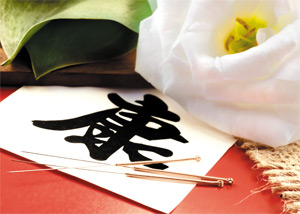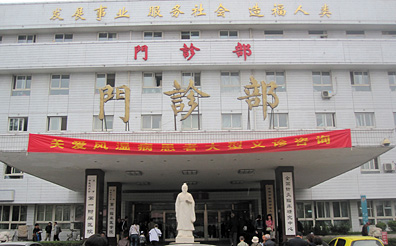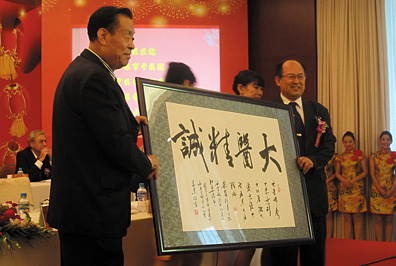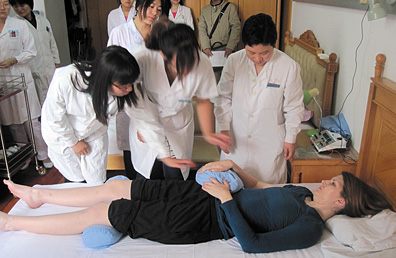Editor's Note: This is the first in a series exploring acupuncture care in China. In October, I traveled to Tianjin and Beijing for a glimpse into where acupuncture is headed and what practitioners in the United States can learn from the latest innovative treatments abroad.
Tianjin, China – On the 12th floor of the First Teaching Hospital in Tianjin of TCM, 27-year-old stroke patient Ashley Boyes waited anxiously for her doctors to enter her room so she could greet them with a simple "hello."
The road to recovery for Boyes has been long. Three years ago the Arizona resident lost her speech and mobility on the right side of her body.
She and her family struggled to find the proper care in the United States. Frustrated with the lack of improvement after undergoing surgery on the left side of her skull and extensive physical therapy Boyes came to Tianjin.
"We have seen some dramatic results here," said her mother, Esther House, who has been overseeing Boyes' care at the highly regarded Chinese medical institution. "She went from not being able to make a sound to putting a few words together and having some movement."
Now, after six weeks of treatment, the doctors filed in. Tracy's eyes brightened.
"Hello."
 Seeking Help in China
Seeking Help in China
Boyes is one of the thousands of Americans who travel more than 7,000 miles every year to seek the specialized Traditional Chinese Medicine (TCM) care that the First Teaching Hospital in Tianjin has to offer. Like them, Boyes came here as a last resort: Acupuncture was her final attempt to get her life back.
Boyes' mother said it was after seeing the documentary "9000 Needles," which profiled a former body builder's recovery efforts from a stroke at the Tianjin hospital, that she was motivated to seek care for her daughter in China.
Boyes' mother and father were new to acupuncture and felt it was worth the trip after watching the film to try something that did not involve much invasive treatment and showed promising results in others.
"We are saddened that more people cannot take advantage of this level of care in the U.S.," said House. "Based on what we have seen, we have high hopes Ashley will not need substantial treatment after being here."
With more than 1,760 staff members, the hospital is well equipped to handle a steady stream of patients. In 2011, the number of outpatients reached 240,000 and the rate of sickbed utilization has remained at 100 percent for the past 17 years, according to hospital officials.
A typical day of care involves over five hours of treatment that include tuina massage, herbal baths, physical therapy and extensive electro acupuncture by numerous doctors and their student assistants.
 One of the three main medical towers of the First Teaching Hospital in Tianjin, China.
The Chinese government made efforts in 2010 to grow the hospital, which is the largest TCM medical center in the country, by approving an expansion that will be complete in 2014, 60 years after it was established.
One of the three main medical towers of the First Teaching Hospital in Tianjin, China.
The Chinese government made efforts in 2010 to grow the hospital, which is the largest TCM medical center in the country, by approving an expansion that will be complete in 2014, 60 years after it was established.
The medical buildings now cover an area of more than 861,000 square feet. When the expansion is done the center will cover more than 1.7 million square feet with additional hospital towers and a research facility.
In the birthplace of acupuncture, TCM is more than a "complementary" treatment. For many Chinese it is recognized as primary care, and the Tianjin hospital is the first stop for most people in the area when it comes to their health.
Stellar Care A Priority
As dawn breaks, the entrance corridor of the First Teaching Hospital is crowded and bustling with patients.
They come seeking medical attention for an array of ailments, ranging from strokes to mild gastrointestinal maladies. With 103 special disease clinics, the hospital is run efficiently to accommodate the crowds in the morning with a fast triage system that includes a tongue and pulse assessment and quick blood work.
A long list of specialists' names lines the wall at the entrance of the hospital, among them five experts conferred by the Tianjin municipal government, 12 internationally famous doctors, 161 doctors with high-grade professional titles, and 201 doctors with assistant professorship titles.
The hospital is also an education hub that attracts 24 doctoral candidate tutors and 169 master's candidate tutors.
Traditional Chinese Medicine takes on a new meaning in Tianjin. In the United States, many TCM patients are known for seeking treatment after trying out Western medicine and not seeing any results, in China the process is reversed.
Patients seek TCM first and, if necessary, they will follow up with Western treatment if needed to complement their Eastern treatment.
The advantage of the Tianjin hospital is that it can offer both.
Often during the consultation, a TCM doctor surrounded by students and interns will make a "differentiation" or TCM diagnosis, and chart out a treatment strategy. They will then recommend both the number and the frequency of treatments that include Eastern and Western techniques.
The hospital has set itself apart for not simply treating illness, but also taking the whole person -- body, mind and spirit -- and finding solutions to their ailments combining a care program that is weaved in with Western medical techniques and tests.
"Patients get a lot more tools to manage their condition here," said Alex Chen, L.A.c., DAOM, from San Francisco, Calif., who was doing a professional internship at the hospital this past fall. "What makes care unique here is that both Eastern and Western medicine is used to get the best treatment for patients."
Although TCM is the primary source of care, the hospital is well equipped with Western technology, including 1,000 types of medical equipment, such as CAT scans, MRI machines and laboratories to aid physicians in treating their patients.
Making this type of high tech TCM care affordable and accessible to the masses is a high priority in Tianjin.
"For $2 you get seen by the doctor here, a medical file costs you no more than a few cents and your wait time is often no more than 15 minutes," said Jing Liu, L.Ac, from the Scottsdale, Ariz.-based Eastern Medical Center who trains at the hospital annually. "Blood tests are done on the spot, you get the results the same day and you get a diagnosis right away so the problem can be fixed."
As in many hospitals in China, access to acupuncture mimics what is known in the U.S. as "community acupuncture" – the acupuncture is made affordable and often treatment is done in-group settings for those with minor ailments.
However, care for serious health issues such as stroke or cancer is much more thorough, entailing laboratory work and frequent follow-ups.
 Dr. Shi Xue Min being honored for 50 years of service at the first teaching hospital of Tianjin.
Dr. Shi Xue Min, one of the hospital's top officials and stroke rehabilitation expert said he feels the First Teaching Hospital of Tianjin is a good example of what the future could hold for acupuncture in the United States if treatment were more readily available and accessible to the masses.
Dr. Shi Xue Min being honored for 50 years of service at the first teaching hospital of Tianjin.
Dr. Shi Xue Min, one of the hospital's top officials and stroke rehabilitation expert said he feels the First Teaching Hospital of Tianjin is a good example of what the future could hold for acupuncture in the United States if treatment were more readily available and accessible to the masses.
"The insurance companies in China have very few restrictions on covering the acupuncture expense. So patients in China can receive sufficient treatment," said Dr. Shi, via a translator. "But in America, most of the insurance companies more or less have difficulty covering acupuncture. From the financial perspective, many patients are concerned about the expense or the frequency of the treatment, so it's difficult to achieve the acupuncture quantitative-effect relation."
The low cost of acupuncture in China is what allows patients to be better served with more frequency.
To serve the large influx of patients who make their way to the hospital daily, acupuncture doctors have also reached high education levels and have committed to rigorous training not yet seen in the states, according to staff at the Tianjin hospital.
Most of the physicians study three years for their master's degrees, three years for their PhD and have to complete medical training and three years of observations.
Only five percent of those who pass the final exam are allowed to needle a patient, according to the staff.
Doctors of TCM in China are also given the right to prescribe drugs when necessary – something that's not allowed in the United States.
"Acupuncturists who come here are able to see the range of acupuncture in the role of disease management a lot better," said Chen. "There are also a lot of techniques not available in the states that benefit patients dramatically, and that is the biggest difference."
Making A Mark
Among some of those techniques are herbal injections, point injections and bloodletting. There is also the hospital's most popular and sought-after treatment, Xing Nao Kai Qiao, or XNKQ, which is an acupuncture stroke treatment developed by Dr. Shi.
Xing Nao Kai Qiao is translated as "activating the brain and opening the orifices." The principle points of the XNKQ method include Du 26, P 6, Sp 6, Lu 5, Ht 1, and UB 40. Du 26 is a point that was highly regarded historically for emergency situations; it can directly excite and activate the restrained state of the brain cells. It has a special characteristic of increasing the circulation of the carotid artery, which helps the dynamics of blood circulation and improves cerebral circulation, according to Dr. Shi.
The hospital has received wide attention for this treatment in recent years, and the interest of U.S. acupuncturists in the technique has grown dramatically since Dr. Shi introduced it.
Last year marked 50 years of service by Dr. Shi at the hospital. To date, he is the most sought-after doctor there and is well known in TCM circles all over the country as the "godfather of acupuncture."
His famed technique was highlighted in the film "9000 Needles" in 2010. In 2011, Dr. Shi also trademarked the treatment in the United States.
Min's greatest contribution has been recognized as XNKQ, primarily for the success rate of the thousands of patients who come from all over the world to be treated at the Tianjin hospital.
According to the most recent statistics noted at the hospital, the clinical recovery rate with XNKQ for the acute and recovery phase is 88.5 percent; the total effective rate has reached 98.5 percent. The effective rate for the stroke sequel is 85.5 percent.
"The majority of the American patients who came to the first Teaching Hospital in Tianjin had been treated in America with Western medicine and they want their progress to go further," said Dr. Shi via his translator. "After receiving three-month treatment in the First Teaching Hospital in Tianjin, the majority of them improve with different degrees. For those less severe stroke patients, they could take care of themselves and return back to their normal lives after treatment."
Dr. Shi noted that what often prevents a stroke relapse for many of the patients treated with XNKQ in Tianjin is that the acupuncture is able to help reduce high blood pressure and increase low blood pressure for those who suffer a stroke due to the hypertension or hypotension.
Not having to worry about relapsing is the type of recovery most patients in the stroke rehabilitation section of the hospital hope to achieve.
Ohioan Looks to Recovery
Like American patient Boyes, Ken Kreuz, 75, of Sylvania, Ohio has high hope for a speedy recovery at the Tianjin hospital from the stroke he suffered in 2011.
 Ashley Boyes of Arizona receiving her daily stroke rehabilitation treatment in Tianjin.
This past fall, Kreuz was undergoing XNKQ treatment primarily for his mobility issues after he suffered a stroke the previous year. Kreuz said there was no indication he had previous health problems and suffered a stroke ironically while working out with his wife Sue.
Ashley Boyes of Arizona receiving her daily stroke rehabilitation treatment in Tianjin.
This past fall, Kreuz was undergoing XNKQ treatment primarily for his mobility issues after he suffered a stroke the previous year. Kreuz said there was no indication he had previous health problems and suffered a stroke ironically while working out with his wife Sue.
Initially, Kreuz sought treatment at the University of Michigan; there he said doctors were trying to assess his recovery treatment for months.
"The therapist at the University of Michigan said 'why are you here?' Because I am an active senior soft ball player and a golfer," said Kreuz while receiving a tuina massage at the Tianjin hospital in October. "They don't know why this happened to me."
Sue Kreuz said her and her husband decided to get educated about their options in alternative care. The couple read "Coming Out of Darkness" by Ruth Lycke, which chronicled her experience recovering from a stroke, and also watched Dr. Shi in 9000 Needles before making the trek to Tianjin.
"When we met with the staff at the University of Michigan they told us if this had happened to them they would come to this hospital," said Sue Kreuz, who was overseeing her husband's care at the Tianjin facility.
Ken Kreuz said he had been receiving care at the Tianjin hospital for two and a half months this past fall and was pleased with the results following XNKQ.
"I don't think his arm would have the range that is has now," said Sue Kreuz. "The attention he has been getting is unbelievable here."
Ken Kreuz, like the other Americans at the hospital, normally receive a medical visa from the United States for a few months. In that time, patients like Kreuz and Boyes hope to gain more mobility and strength than they have lost.
"I'd like to be playing left field for the Detroit Tigers soon," joked Kreuz. "But, in all honesty I am satisfied. I don't know where I'd be if it weren't for this place."
The ideal treatment of XNKQ is recommended for patients such as Kreuz and Boyes to be twice a day at the Tianjin hospital.
Early Results
For Boyes, recovery results were seen soon after her third acupuncture treatment. Boyes' mother said she was able to say the word "mango" initially and gained some movement in her arm following her acupuncture session, which included 3-inch, heavy gauge needles, typically used in China.
"It truly is shocking that back home the medical community doesn't seem to accept this treatment – either they are skeptical or have no opinion," said House, Boyes' mother. "This treatment should be on the rise, this could be the future."
This trip was sponsored by Jing Liu & Eastern Medicine Center.
Part II of the AT in China series will look at TCM education in China. For questions, email me at .



